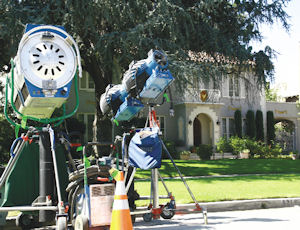On-location commercial filming increased in the first quarter in the greater Los Angeles area, the continuation of a pattern from 2010 as advertising pulled out of the doldrums of the recession. For the first three months of the year, commercial filming went up by 49 permitted production days, or 2.4 percent, over the same period in 2010, according to FilmL.A., the not for profit that coordinates on-location filming for the city and county of Los Angeles, and other jurisdictions. Commercial filming was the only category to show an increase in the first quarter. On-location feature films and television series dropped in that period. Since much of commercial filming takes place on location rather than on soundstages – 71 percent in 2008 and 67 percent in 2009 – the figures released from FilmL.A. are a good indication that advertising spending is returning. But one industry organization cautioned that the improvement in 2010 of 6,778 permitted days was merely a rebound from a bad 2009 when there were 5,292 permitted days and should not be overemphasized. San Fernando Valley: Geico – 11900 block of Oxnard Street, Woodland Hills Geico – 6000 block of Radford Avenue, Studio City 3M – 15600 block of Royal Ridge Road, Encino AT&T – 4100 block of Stansbury Avenue, Sherman Oaks Build a Bear – 9300 block of Tampa Avenue, Northridge City of Santa Clarita: Harrahs – Oak Orchard and Placerita Canyon Burger King & Wendy’s – College of the Canyons Enterprise – auto dealership on Creekside Home Depot – neighborhood at Lyons and Apple Wal-Mart – Carl Boyer and Newhall Ranch Arbys – Sierra Highway and Soledad Antelope Valley: BMW – Avenue G at 200th Street East Buick – 70th Street East, from Palmdale Boulevard to Avenue N Hertz – Avenue G at 245th Street East Church’s Chicken – Avenue H at 110th Street East Dodge – Avenue G at 175th Street East Commercial filming this year will be more reflective of the status of the advertising industry, said David Phelps, director of external relations for the Association of Independent Commercial Producers. “We are hoping to see stabilization in activity,” Phelps said. “The most recent numbers reflect that trend.” In the region that is home to the major Hollywood studios commercial filming often gets overlooked as a contributor to the economy. Yet when crews are not working on the feature film or television show, commercial jobs will bring in a paycheck. Commercials as well do their share of showing the world what Southern California – and the entire state – offers. Car companies, especially, are fond of using multiple locales to show off their new models. Downtown and the 2nd Street tunnel portray non-descript urban settings; and there is always a beach to show off sand and surf and sunshine. When those backdrops aren’t called for there is always the desert. “We have wide open spaces and long stretches of roads that give the impression of being in the middle of nowhere,” said Pauline East, who heads up the Antelope Valley Film Office. The number of commercial projects in the areas handled by East – the cities of Lancaster and Palmdale, and unincorporated Los Angeles County – has seen the same rebound as others. For the first nine months of the 2010-11 fiscal year, there have been 51 projects. In the same period in the 2009-10 fiscal year there were 33 projects. For the entire 2008-09 fiscal year, there were only 43 commercial projects in the Antelope Valley with some months not having any at all, East recollected. ‘Musical road’ That commercials can have a drawing power beyond just the product being advertised is evident by the “musical road” in Lancaster. Built for a Honda Civic commercial in 2008, the road was constructed on a stretch of Avenue K with grooves that played a portion of “The William Tell Overture” when a vehicle drove over them. The only problem was that the sound carried for about three miles and disturbed residents. The city would pave over the road and rebuild it on West Avenue G, away from any homes. While people came from miles just to drive over it, the roadway has not made any more appearances in commercials. The City of Santa Clarita doesn’t have a musical road to attract commercial production but it does have its share of popular filming locations. The city, for instance, has become home base for Old Navy, and newer Walgreens and Wal-Mart stores are preferred backdrops for commercials for those chains. Car companies, meanwhile, like the inviting, All-American feel of the residential streets. The city tracks its filming on a July to June fiscal year, and so far has had 123 film days of commercials, or 19 percent of the overall filming. In the 2009-10 fiscal year only 13 percent of filming was commercials. Film friendly “We have a great community setting,” said Jessica Freude, an economic development associate. “We are film friendly and that is advantageous to keeping production local and jobs here.” Keeping production in the state is behind an effort to get legislation passed in Sacramento to offer tax credits for commercial filming. The program would be similar to one offered in New York State, Phelps said. While the wording of the bill is worked out, lawmakers meanwhile will take up extending the tax credits for feature films and television shows. If that extension passes, which the AICP supports, it may prove easier to get the commercial tax credit program passed as well, Phelps said. A separate program for commercial producers would dispel the perception that large studios are benefitting from tax breaks as many AICP members are small- to medium-sized businesses that are privately owned. “Our industry area is where they should invest in to keep film production in California,” Phelps said.
